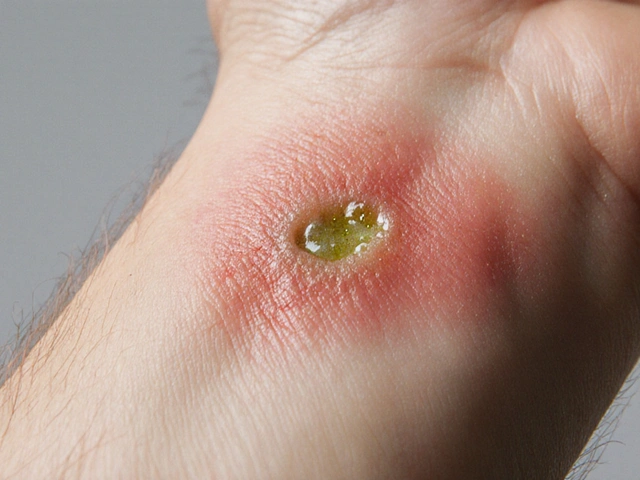Bimat is the brand name for bimatoprost, a medication originally developed to treat high pressure inside the eye - a condition called glaucoma. Over time, doctors and patients noticed something unexpected: people using Bimat for their eyes also grew longer, thicker, darker eyelashes. That side effect turned into a whole new use. Today, Bimat is one of the most trusted prescription treatments for hypotrichosis - the medical term for inadequate eyelash growth.
How Bimat Actually Works
Bimatoprost, the active ingredient in Bimat, is a prostaglandin analog. That means it mimics natural chemicals in your body that help regulate fluid pressure in the eye. In glaucoma patients, it works by increasing the outflow of aqueous humor - the fluid inside your eye - which lowers intraocular pressure and reduces risk of optic nerve damage.
But here’s the twist: the same mechanism that affects fluid flow in the eye also influences hair follicles in the eyelid area. When applied to the base of the upper eyelashes, Bimat extends the growth phase (anagen phase) of the hair cycle. It doesn’t create new follicles. Instead, it wakes up dormant ones and keeps existing ones active longer. The result? Lashes that grow thicker, longer, and darker - usually within 4 to 8 weeks.
Studies show that after 16 weeks of daily use, users gain an average of 25% more lash length and 106% more lash fullness compared to baseline. These aren’t marketing claims - they’re results from clinical trials published in the Journal of the American Academy of Dermatology.
How to Use Bimat Correctly
Using Bimat wrong can lead to wasted product, irritation, or even unwanted hair growth. Here’s how to do it right:
- Wash your hands and face thoroughly. Remove all makeup, especially around the eyes.
- Use the sterile applicator provided with the bottle. Do not reuse old eyeliner brushes or fingers.
- Apply one drop of solution to the applicator brush.
- Draw a thin line along the base of your upper eyelid - like you’re applying eyeliner. Avoid the lower lid unless directed by your doctor.
- Blot any excess with a tissue. Don’t rub your eyes.
- Dispose of the applicator after one use. Never reuse it.
- Use once daily, preferably at night before bed.
Consistency matters. Skip a day? You might not see results. Use it twice a day? You won’t get faster results - you’ll just risk irritation. Stick to once daily. That’s all you need.
Side Effects You Should Know
Bimat is generally safe when used as directed, but it’s not without risks. Most side effects are mild and temporary:
- Itchy or red eyes - the most common, usually fades after a few weeks
- Darkening of the eyelid skin - reversible if you stop using it
- Increased brown pigment in the iris - rare, but permanent
- Unwanted hair growth on the cheeks or around the eyes - happens if product spreads
The most serious concern is iris pigmentation change. If you have light-colored eyes (blue, green, hazel), Bimat can cause gradual darkening over months or years. This isn’t dangerous, but it’s permanent. Once your iris changes color, you can’t reverse it. That’s why doctors screen patients carefully before prescribing Bimat for cosmetic use.
People with a history of eye inflammation, like uveitis or iritis, should avoid Bimat. It can worsen those conditions.

Bimat vs. Over-the-Counter Lash Serums
There are dozens of eyelash serums on the market. Most are marketed as “natural,” “organic,” or “FDA-approved” - but here’s the truth: only one ingredient has FDA approval for eyelash growth, and that’s bimatoprost.
Over-the-counter serums often contain peptides, biotin, or plant extracts. These may hydrate or condition lashes, but they don’t stimulate growth the way Bimat does. No OTC product has been proven in clinical trials to increase lash length or density the way Bimat has.
Here’s a quick comparison:
| Feature | Bimat (bimatoprost) | OTC Serums (e.g., RevitaLash, GrandeLASH) |
|---|---|---|
| Active Ingredient | Bimatoprost (FDA-approved) | Peptides, biotin, panthenol |
| Proven to Grow Lashes? | Yes - clinical data supports 25%+ length increase | No - only anecdotal reports, no peer-reviewed proof |
| Prescription Required? | Yes | No |
| Cost per Month | $70-$120 (with insurance) | $30-$60 |
| Potential Side Effects | Iris darkening, eyelid pigmentation | Mild irritation, redness |
If you want real results, Bimat is the only option backed by science. If you want a gentle, low-risk option with no guarantees, OTC serums might feel safer - but they won’t deliver the same outcome.
Who Should Not Use Bimat
Bimat isn’t for everyone. Avoid it if you:
- Have active eye infections or inflammation
- Are pregnant or breastfeeding (safety not established)
- Have a history of macular edema or retinal issues
- Have light-colored eyes and are concerned about permanent iris darkening
- Are under 18 - it’s not approved for minors
If you’re unsure, talk to an ophthalmologist or dermatologist. They can check your eye health, review your medical history, and tell you if Bimat is right for you.

What Happens When You Stop Using Bimat
Here’s the catch: Bimat doesn’t permanently change your lashes. Once you stop using it, your lashes will gradually return to their original state - usually within 8 to 16 weeks. That’s because the drug only works while it’s actively stimulating the follicles. It doesn’t reprogram them.
That’s why most people keep using it long-term. Many users apply it 2-3 times a week after reaching their desired length. That maintenance routine helps preserve results without the full daily dose.
If you stop and then restart, you’ll likely see results again - but it won’t be as fast as the first time. Your body remembers the effect, but you’ll need to rebuild.
Where to Get Bimat Legally
Bimat is a prescription-only medication in the U.S. You can’t buy it over the counter at CVS or Walgreens. You need a doctor’s note.
Many dermatologists and ophthalmologists prescribe it for cosmetic use. Some telehealth services now offer online consultations specifically for eyelash growth. After a quick review of your eye health, they can send a prescription to your pharmacy.
Be wary of websites selling Bimat without a prescription. These are often counterfeit products - sometimes laced with steroids, bacteria, or inactive ingredients. Fake Bimat has caused corneal ulcers and permanent eye damage in reported cases.
Always fill your prescription at a licensed U.S. pharmacy. If the price seems too good to be true - it is.
Alternatives to Bimat
If Bimat isn’t right for you, here are other options:
- Latanoprost - another prostaglandin analog used for glaucoma. Sometimes prescribed off-label for lashes, but less effective than bimatoprost.
- Travoprost - similar to latanoprost. Rarely used for cosmetic purposes.
- Prescription Minoxidil - sometimes applied to lashes, but not FDA-approved for this use. Higher risk of skin irritation.
- Lash extensions or tinting - temporary cosmetic fixes with no medical risk.
None of these alternatives match Bimat’s proven track record for natural-looking, long-term lash growth.
Can Bimat change the color of my eyes?
Yes, in rare cases. Bimat can cause permanent darkening of the iris, especially in people with light-colored eyes like blue, green, or hazel. This happens slowly over months or years and is irreversible. It’s not dangerous, but it’s permanent. Doctors screen for this risk before prescribing.
How long does it take to see results from Bimat?
Most people notice longer, fuller lashes within 4 to 8 weeks. Full results usually appear after 12 to 16 weeks of daily use. Don’t expect overnight changes - this is a slow, natural process.
Can I use Bimat on my eyebrows?
Yes, many people do - and it works. Bimat is commonly prescribed off-label for sparse eyebrows. Apply the same way: one drop on a clean applicator, drawn along the brow line. Results take longer - usually 8 to 12 weeks. Be careful not to let it run onto your cheeks.
Is Bimat safe for contact lens wearers?
Yes, but remove your contacts before applying Bimat. Wait at least 15 minutes after application before putting them back in. The preservative in the solution can be absorbed by soft lenses and cause irritation.
Does Bimat cause eyelid sagging or wrinkles?
No. There’s no evidence Bimat causes skin laxity or wrinkles. In fact, some studies suggest it may improve skin texture around the eyes by increasing collagen production. Any perceived changes are usually due to swelling or pigmentation, not aging.
If you’re considering Bimat for your lashes, remember: it’s a powerful tool - not a magic wand. It works, but only if you use it correctly and understand the risks. Talk to a doctor. Get the real thing. And don’t rush the process. Your lashes will thank you.





Ronald Stenger
November 20, 2025 AT 03:00Let’s be real - if you’re not using Bimat, you’re wasting your time with those overpriced OTC serums. I’ve seen people spend $50 a month on ‘natural’ nonsense while Bimat gives you real results in 6 weeks. It’s not magic, it’s science. Stop falling for marketing. Get the prescription. Your lashes deserve better.
Samkelo Bodwana
November 21, 2025 AT 22:07Interesting how this drug, originally meant to treat a serious medical condition, ended up becoming a cosmetic phenomenon. It’s a beautiful example of serendipity in pharmacology - a side effect becoming the main event. But I worry about the normalization of medicalizing beauty. We’re not just talking about lashes here; we’re talking about societal pressure to conform to certain aesthetic standards, and how pharmaceutical companies are quick to capitalize on that. Is this progress, or just another way to profit from insecurity?
Emily Entwistle
November 23, 2025 AT 06:41OMG I started Bimat 3 months ago and my lashes are UNREAL 🤯👀 Like, I don’t even wear mascara anymore - my friends keep asking if I got extensions 😍 The only downside? I got a little darkening under my eyes but it faded after I cut back to 3x/week. Also, DO NOT use the same brush twice - I learned that the hard way 😅
Duncan Prowel
November 24, 2025 AT 08:34While the clinical efficacy of bimatoprost is well-documented, I must emphasize the importance of distinguishing between off-label cosmetic use and its primary therapeutic indication. The pharmacokinetics of topical ocular application differ significantly from systemic administration, and the potential for iris pigmentation changes - though rare - warrants rigorous patient counseling. Furthermore, the regulatory status of this compound as a prescription-only agent in the United States underscores the necessity of professional oversight, rather than self-medication via unregulated online vendors.
benedict nwokedi
November 26, 2025 AT 07:30deepak kumar
November 26, 2025 AT 21:16As someone from India, I’ve seen so many people buy fake Bimat from shady websites. Please, please, please - get it from a licensed pharmacy. I had a cousin who used a counterfeit version and got a corneal ulcer. It took months to heal. Bimat works, but only if it’s real. Also, yes - it works on eyebrows too! I used it for mine after chemo and now I get compliments every day 😊
Dave Pritchard
November 28, 2025 AT 21:00For anyone thinking about trying this - start slow. Use it every other day for the first two weeks. If your eyes get red or itchy, take a break. You don’t need to use it daily to see results, and your skin will thank you. And if you’re worried about cost, some telehealth clinics offer discounts. You’re not alone in this. Many of us are walking the same path - just trying to feel better in our own skin.
kim pu
November 30, 2025 AT 07:38Bimat? More like BIMAT-TRAP. 🤡 Who even came up with this? You’re basically injecting a glaucoma drug into your face like it’s a TikTok hack. And don’t even get me started on the ‘maintenance dose’ BS - that’s just the pharma bros trying to lock you in for life. I’d rather have short lashes and a clear conscience than a $100/month habit and brown eyes. #NoMoreBeautyChemistry
malik recoba
November 30, 2025 AT 09:07i used bimat for a while and it worked great! my lashes got super long. but i stopped because i was scared about the eye color thing. i have green eyes and i didn’t want to risk it. now i just use a good lash serum and call it good. not as strong, but safer for me. also, i always wash my hands before applying - small thing, but it helped me not get any weird irritation.
Sarbjit Singh
December 1, 2025 AT 19:42Hey guys, I'm from India and I've been using Bimat for 6 months now - my lashes are crazy thick! 😊 But please, if you're thinking of trying it, talk to a doctor first. I got mine through a local ophthalmologist and he checked my eyes before prescribing. Also, use the applicator only once - I reused one once and got a tiny infection. Don't be like me! 😅
Angela J
December 2, 2025 AT 17:55So… what if the iris darkening is just the beginning? What if it’s a gateway? What if they’re slowly changing our DNA through topical meds? I’ve read studies - they don’t mention long-term epigenetic effects. And why is it only approved for upper lashes? Why not lower? Why not eyebrows? It’s too convenient. They’re testing on us. And the ‘permanent’ part? That’s not a side effect - it’s a feature. 🧬👁️
Shravan Jain
December 3, 2025 AT 18:12Let’s not romanticize pharmaceutical serendipity. Bimatoprost was never designed for aesthetics. Its repurposing reflects a broader cultural pathology: the commodification of bodily autonomy under the guise of medical advancement. One must ask: if a drug’s most profitable outcome is a side effect, does that not reveal a fundamental flaw in the incentive structure of modern medicine? We are not treating disease - we are manufacturing desire.
Joshua Casella
December 5, 2025 AT 11:50Look, I get it - you want longer lashes. But don’t let your vanity override your common sense. I’ve seen too many people ignore the risks because they saw a before-and-after on Instagram. Bimat is not a beauty product. It’s a prescription drug with serious potential consequences. If you’re not willing to see an actual doctor, you don’t deserve to use it. Period. No exceptions. No shortcuts. Your eyes are not a filter.